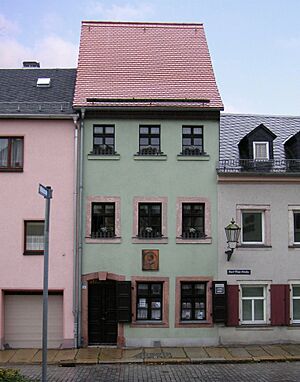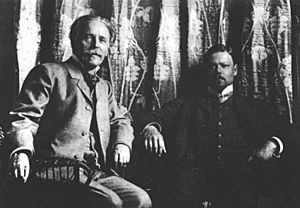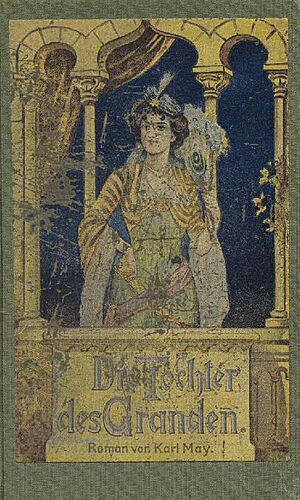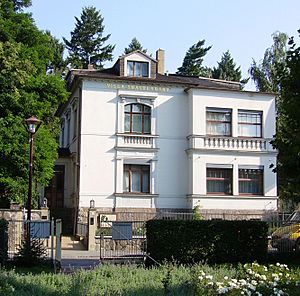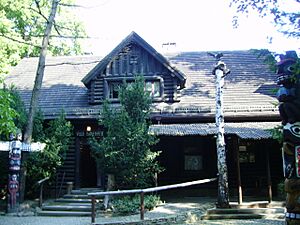Karl May facts for kids
Quick facts for kids
Karl May
|
|
|---|---|
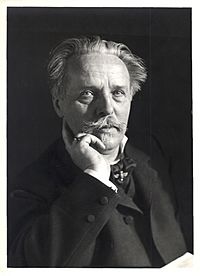 |
|
| Born | Karl Friedrich May 25 February 1842 Ernstthal, Kingdom of Saxony, German Confederation |
| Died | 30 March 1912 (aged 70) Radebeul, Kingdom of Saxony, German Empire |
| Occupation | Writer, author |
| Genre | Western, travel fiction, German homeland novels, adventure novels |
Karl Friedrich May (pronounced MY; born February 25, 1842 – died March 30, 1912) was a famous German author. He is best known for his exciting adventure novels. Many of his stories are set in the American Old West with heroes like Winnetou and Old Shatterhand. Other popular books take place in the Orient and Middle East with characters like Kara Ben Nemsi and Hadschi Halef Omar.
Karl May also wrote novels set in Latin America, China, and Germany. He wrote poetry, a play, and even composed music. He was very good at playing several musical instruments. Many of his works were made into movies, stage plays, audio dramas, and comics. Later in his life, May's writing focused more on ideas about life and spirituality. He is one of the best-selling German writers ever, with about 200 million copies of his books sold worldwide.
Contents
Karl May's Life Story
Early Life and Challenges
Karl May was born into a poor family of weavers in a town called Ernstthal, in what was then the Kingdom of Saxony. He was the fifth of 14 children, but sadly, nine of his siblings died when they were very young.
During his school years, Karl May learned a lot about music and how to compose it. When he was 12, he earned money working at a bowling alley. This job exposed him to some rough language and situations.
Difficult Times and Prison
In 1856, May started training to become a teacher. However, in 1859, he was expelled for taking six candles. After appealing, he was allowed to continue his training elsewhere. Soon after he graduated, his roommate accused him of stealing a watch. May was sent to jail for six weeks, and he lost his teaching license forever.
After this, May tried working as a private tutor, a writer, a composer, and a public speaker, but he didn't have much success. For four years, from 1865 to 1869, May was in a workhouse prison. Because he behaved well, he became the administrator of the prison library. This gave him a great chance to read many books. He even made a list of all the stories he wanted to write one day.
After his release, May continued to have legal troubles. He was arrested again and spent another four years in jail from 1870 to 1874. While there, he met a kind Catholic teacher, Johannes Kochta, who helped him.
Becoming a Famous Writer
After being released from prison in May 1874, Karl May went back to his parents' home and started writing seriously. His first published work was "The Rose from Ernstthal" in November 1874. He then worked as an editor for a publishing house in Dresden. He managed entertainment papers and published his own stories.
In 1878, May became a freelance writer, meaning he worked for himself. In 1880, he married Emma Pollmer. He faced financial difficulties again. In 1882, he returned to working for his old publisher and began writing long adventure novels. One of these was "Das Waldröschen" (1882–1884).
May's stories also appeared in a Catholic weekly magazine called Deutscher Hausschatz (German House Treasure). He started his famous "Orient Cycle" series in 1880. He also wrote for a teenage boys' journal called Der Gute Kamerad (The Good Comrade). In 1887, it published "Son of the Bear Hunter," and in 1891, "The Treasure of Silver Lake."
In 1891, a publisher named Friedrich Ernst Fehsenfeld offered to print May's stories as books. In 1892, the publication of Karl May's Collected Travel Accounts brought him financial security and fame. May became deeply involved in his stories and characters. Readers often wrote to him, calling him by the names of his book heroes. May even went on speaking tours in Germany and Austria. He had autographed cards printed and took photos dressed in costumes from his books. In 1895, May moved into a large house he called Villa Shatterhand.
Later Years and Passing
In 1899, May traveled to Egypt and then Sumatra. He returned to Germany in 1900. During this time, he faced some public criticism for how he promoted himself and for some of his writings. In 1902, he received an honorary doctorate degree from a university in Chicago.
In 1908, Karl and Klara May spent six weeks in North America. They visited places like Niagara Falls. This trip inspired May to write "Winnetou IV."
After his return, May began writing more complex stories. These later works explored ideas about humanity, pacifism (the belief that war is wrong), and how people can become better. On March 22, 1912, May gave a lecture in Vienna called "Upward to the Realm of Noble Men," where he met the famous peace activist Bertha von Suttner.
Karl May passed away one week later, on March 30, 1912, in his home, Villa Shatterhand. He was buried in Radebeul East. His tomb was designed to look like the ancient Temple of Athena Nike.
Karl May's Books
How He Wrote His Stories
Karl May used many different pen names, like "Hobble-Frank" and "Prinz Muhamel Lautréamont." Most of his works published under these names have now been identified as his.
For his novels set in America, May created the famous characters of Winnetou, the wise chief of the Apaches, and Old Shatterhand, Winnetou's white blood brother. Another series of novels took place in the Ottoman Empire. In these, the main character, Kara Ben Nemsi, travels with his guide Hadschi Halef Omar through the Sahara desert and the Near East, having many exciting adventures.
Interestingly, with only a few exceptions, May had never actually visited the places he wrote about! He made up for this by using his amazing creativity and imagination. He also used maps, travel books, guidebooks, and studies about different cultures and languages to make his stories feel real. He was inspired by other writers like James Fenimore Cooper.
Christian values, but not strict religious rules, are important in May's books. Some of his characters are described as being German, especially from Saxony. In his later works (after 1900), May moved away from pure adventure stories. He started writing more symbolic novels with religious and peaceful messages.
Types of Stories He Wrote
Karl May wrote in many different styles before he became known for his travel stories.
- Early Adventure and Travel Stories: These include tales like "Inn-nu-woh, the Indian Chief" (1875).
- Historical Fiction: Stories based on real historical events, such as "Robert Surcouf" (1882).
- Humorous Stories: Funny tales like "The Carnival Fools" (1875).
- Stories about the Ore Mountains: These were often set in villages, like "The Rose from Ernstthal" (1874 or 1875).
Long Adventure Novels
May wrote five very long novels, each thousands of pages long. He published these anonymously or under pen names between 1882 and 1888. Some of these include:
- Das Waldröschen (1882–1884)
- Die Liebe des Ulanen (1883–1885)
Famous Travel Stories
From 1892 to 1910, 33 volumes of Karl May's Collected Travel Accounts were published. Most of these had appeared before in Deutscher Hausschatz. The most famous are the "Orient Cycle" (volumes 1-6) and the "Winnetou-Trilogy" (volumes 7-9).
Some popular titles from this series include:
- Durch Wüste und Harem (1892, later called Durch die Wüste)
- Durchs wilde Kurdistan (1892)
- Winnetou I (1893)
- Winnetou II (1893)
- Winnetou III (1893)
- Der Schut (1892)
- Der Schatz im Silbersee (1891)
Stories for Young Readers
These stories were written for the magazine Der Gute Kamerad from 1887 to 1897. Most are set in the Wild West. In these stories, Old Shatterhand is a character, but he doesn't tell the story himself. The most famous book in this group is Der Schatz im Silbersee (The Treasure of Silver Lake).
Other stories for young readers include:
- Der Sohn des Bärenjägers (1887)
- Die Sklavenkarawane (1890)
- Das Vermächtnis des Inka (1892)
- Der Oelprinz (1894, later called Der Ölprinz)
Later Works
May's later works, written after 1900, were often published by Fehsenfeld. These books explored deeper, more philosophical themes.
- Himmelsgedanken (1900, a collection of poems)
- Und Friede auf Erden! (1904, meaning "And Peace on Earth!")
- Ardistan und Dschinnistan I (1909)
- Ardistan und Dschinnistan II (1909)
- Winnetou IV (1910)
- Mein Leben und Streben (1910, his autobiography)
How Many Copies Were Sold?
Karl May is often called the "most read writer of the German language." About 200 million copies of his books have been published in total, with half of them in German. His works have been translated into more than 30 languages, including Latin, Bulgarian, and Esperanto. In the 1960s, UNESCO stated that May was the most translated German writer.
Karl May's Impact
Influence on German Culture
Karl May had a huge influence on many famous German-speaking people and on the German public. His popular stories and German heroes helped fill a need in the German spirit for popular heroes. His readers wanted to escape from the industrial world, and May's books offered that escape. He helped shape the "German dream" of great adventures and contributed to how Native Americans were seen in German-speaking countries.
The name Winnetou is even in the German dictionary! After World War II, American soldiers were surprised to find that German children knew all about "Cowboys and Indians" because of May's books, even if the stories were very different from reality.
Many famous German-speaking people looked up to May's heroes when they were children. Albert Einstein loved May's books, saying, "My whole adolescence stood under his sign. Indeed, even today, he has been dear to me in many a desperate hour..."
Karl May and Politics
Adolf Hitler was one of Karl May's admirers. He mentioned in his book Mein Kampf that May's novels "overwhelmed" him as a boy and even caused his school grades to drop. Hitler later recommended May's books to his generals. He admired May's imagination, especially since May wrote about places he had never visited.
However, Hitler completely ignored May's true messages of peace and kindness, as well as his respectful descriptions of people from different backgrounds. May's last lecture, which Hitler may have attended, was actually a strong call for peace. The popularity of May's books was sometimes used by the Nazis during the world wars for their own purposes, but this was against May's original intentions and messages.
"Indianthusiasm" in Germany
May's popular books created a strong fascination in German culture with the Native Americans of North America. This interest continues even today. This phenomenon is sometimes called "Indianthusiasm."
As part of this "Indianthusiasm," there are several Western and Native American theme parks in Germany. May's books also inspired hobby clubs where Germans pretend to be cowboys or Native Americans. The first such club was founded in Munich in 1913. Today, tens of thousands of Germans are involved in these clubs. They might live in tipis, wear traditional clothes, and even re-enact battles.
Influence on Other Authors
The German writer Carl Zuckmayer was so inspired by May's Apache chief that he named his daughter Maria Winnetou. Max von der Grün said that reading May's books as a boy helped him overcome his fear of thick books.
Heinz Werner Höber, a prize-winning German writer, was also a big fan. He said, "When I was about 12 years old I wrote my first novel on Native Americans which was, of course, from the beginning to the end completely stolen from Karl May."
Books, Movies, and More
Adaptations of His Works
Karl May's poem Ave Maria (1896) has been set to music in at least 19 different versions. Other poems were also turned into songs.
The first stage play based on May's work was Winnetou in 1919. Since the 1940s, different versions of his novels have been performed on outdoor stages. The Karl May Festival in Bad Segeberg has been held every summer since 1952, and another in Lennestadt-Elspe since 1958. At some of these festivals, the actor Pierre Brice played Winnetou.
In 1920, May's friend Marie Luise Droop and her husband started a film company called Ustad-Film. They made three silent movies based on the "Orient Cycle," but these films are now lost. The first sound movie, Durch die Wüste, was shown in 1936.
From 1962 to 1968, a popular series of Karl May movies were made. Most of these 17 films were Wild West movies, starting with Der Schatz im Silbersee. Three were based on the "Orient Cycle," and two on Das Waldröschen. Actors like Lex Barker (Old Shatterhand) and Pierre Brice (Winnetou) became very famous. The music by Martin Böttcher and the beautiful landscapes of Yugoslavia are strongly linked to these movies.
May's works have also been adapted into about 300 audio dramas, especially in the 1960s. The first was Der Schatz im Silbersee in 1929. There are also Czech and Danish versions.
In the 1950s, Croatian comic book artist Walter Neugebauer created a comic book adaptation of Karl May's stories. In the 1960s and 1970s, May's works were adapted into German comics, including an eight-issue series based on Winnetou. Belgian artist Willy Vandersteen also created a whole series of comics called Karl May.
May's own life has been the subject of movies, novels, and plays, such as the film Karl May (1974).
His Legacy Lives On
An Asteroid named 15728 Karlmay was named in May's honor.
Karl May Organizations
Karl May Foundation
In his will, Karl May stated that after his second wife, Klara, passed away, all his property and future earnings from his work should go to a foundation. This foundation was meant to help educate talented poor people, including writers, journalists, and editors.
One year after May's death, in 1913, Klara May established the "Karl May Foundation." The foundation received Klara and Karl May's estate. It also set up the Karl May Museum to take care of Villa Shatterhand, his belongings, collections, and May's tomb. In 1960, the Karl May Foundation also received the Karl May Press.
Karl May Press
On July 1, 1913, Klara May, Friedrich Ernst Fehsenfeld (May's main publisher), and a lawyer named Euchar Albrecht Schmid started the "Foundation Press Fehsenfeld & Co." in Radebeul. In 1915, its name changed to "Karl May Press" (KMV). The KMV gathered the rights to May's works from other publishers. They also added revised versions of his texts to the series Karl May’s Collected Travel Accounts, which was renamed Karl May’s Collected Works. By 1945, there were 65 volumes.
The Karl May Press focuses only on May's work and related books. Besides the Collected Works (the classic "green volumes"), which now have 91 volumes, the press also reprints many other books. The Karl May Press aims to protect May's reputation from criticism and support the Karl May Foundation. The name "Karl May" is a registered trade mark of the company that belongs to the Karl May Press.
Karl May Museums
Radebeul Museum
The Karl May Museum is located in Villa Shatterhand in Radebeul. It has items from May's life, as well as artifacts from the American frontier and Native American life of that time. It was founded in 1928 by May's widow and an Austrian collector named Ernst Tobis.
For a time, the museum in Radebeul was called the "Indianer Museum" because May's books were not promoted by the government in East Germany. Its original name was restored in 1986.
Hohenstein-Ernstthal Museum
The "Karl May House" is the three-centuries-old weaver house where May was born. Since 1985, it has been a memorial and museum. It shows an original weaving room and copies of his books from other countries. The garden is designed to match May's descriptions in his memoirs.
Across from the house is the International Karl May Heritage Center. This building is used for events and special exhibitions. In Hohenstein-Ernstthal, which has been called "Karl May Home Town" since 1992, every place connected to May has a special sign. These places are linked by a "Karl May Path." Outside the city is the "Karl May Cave," where May found shelter during his difficult times.
Karl May Societies
Today, various groups focus on researching Karl May and his works. These organizations exist in German-speaking countries, the Netherlands, Australia, and Indonesia. They publish most of the magazines and newsletters related to May.
The "Karl May Society" (KMG), founded in 1969, is the largest organization, with about 1800 members. The KMG publishes yearbooks, newsletters, and special editions. Since 2008, working with the Karl May Foundation and Karl May Press, the KMG has been publishing a detailed, scholarly edition of "Karl Mays Werke."
Images for kids
See also
 In Spanish: Karl May para niños
In Spanish: Karl May para niños


